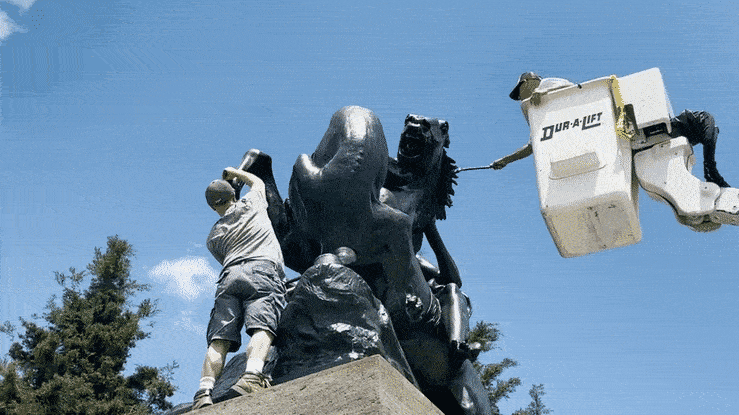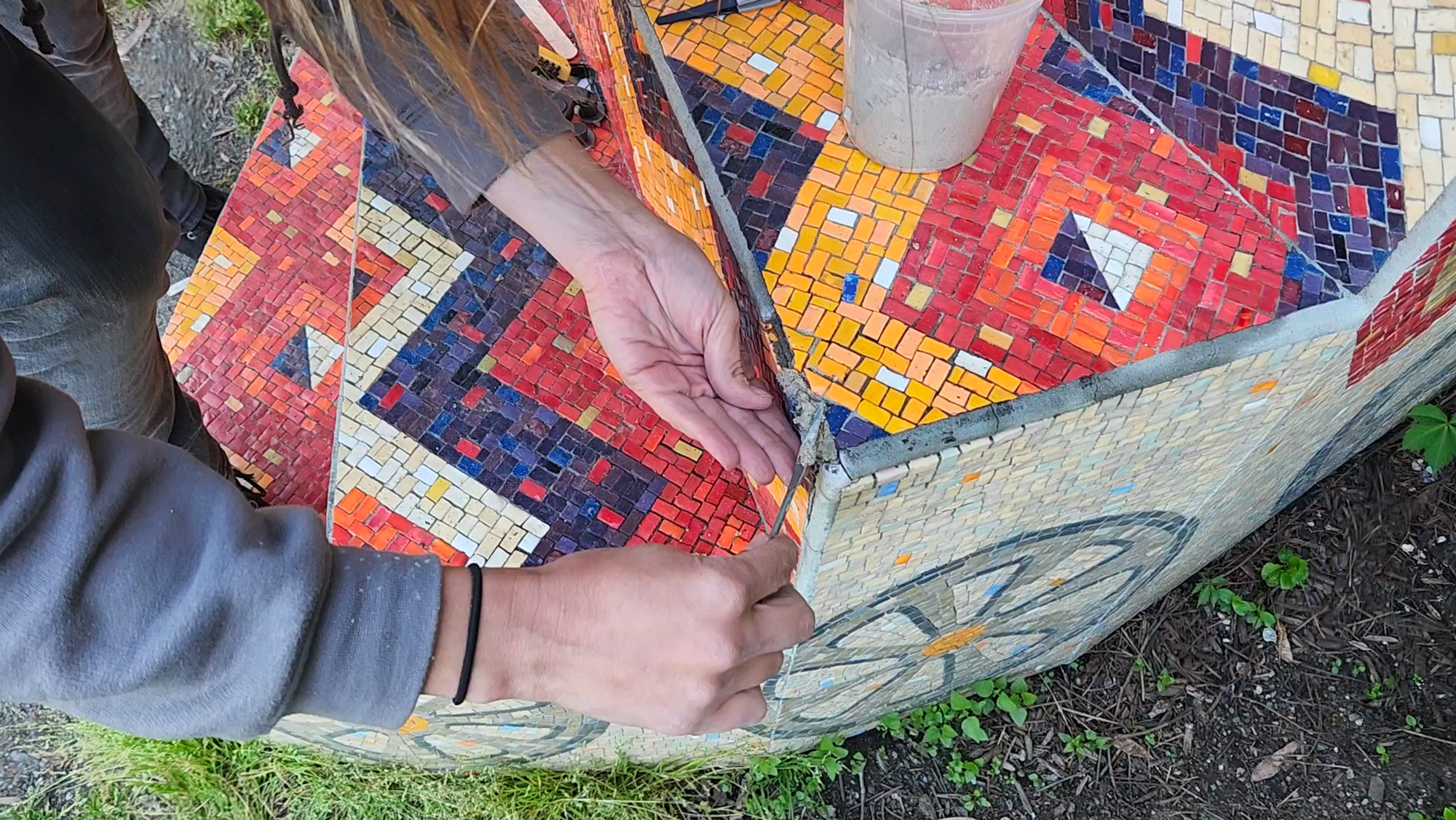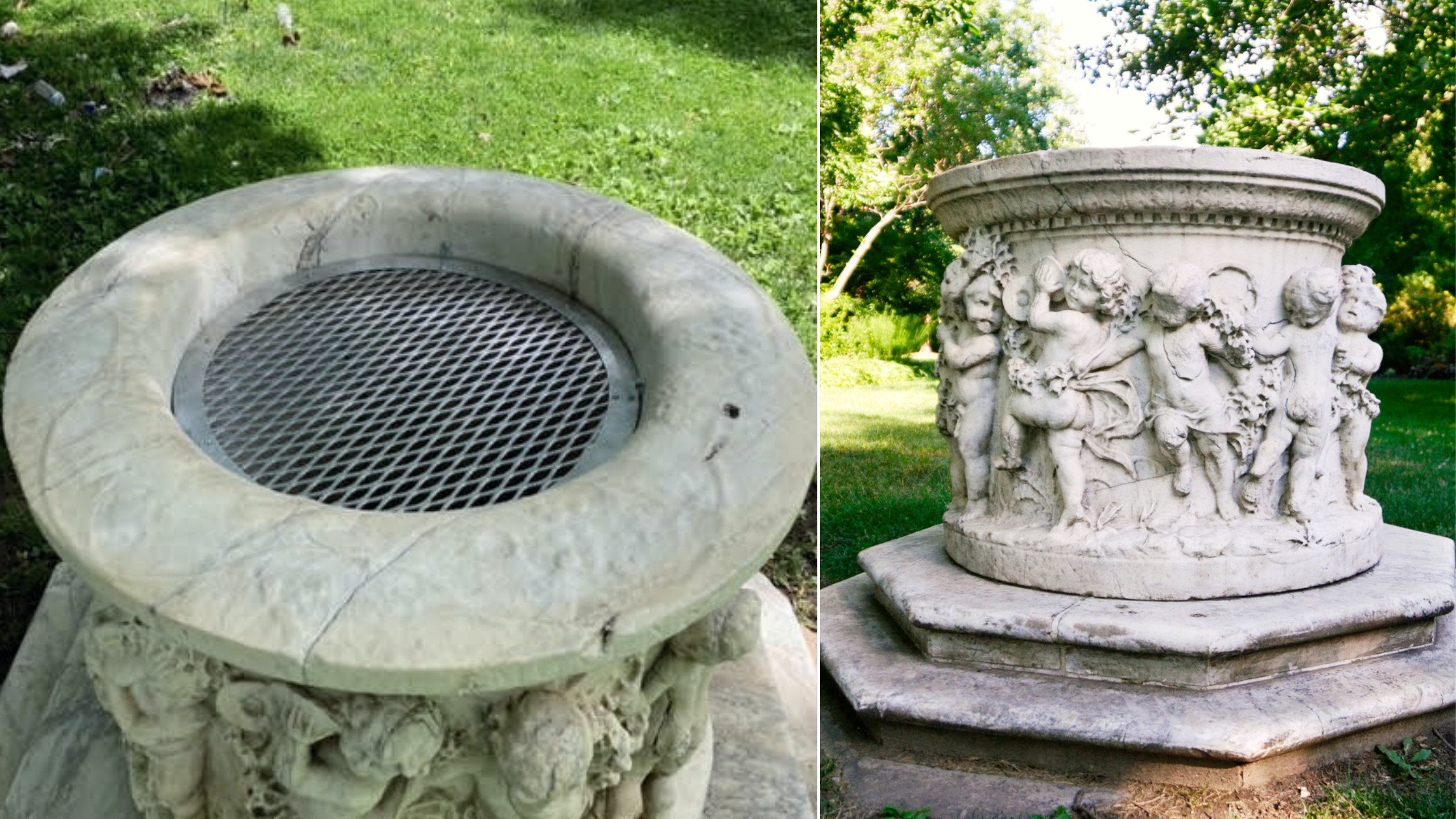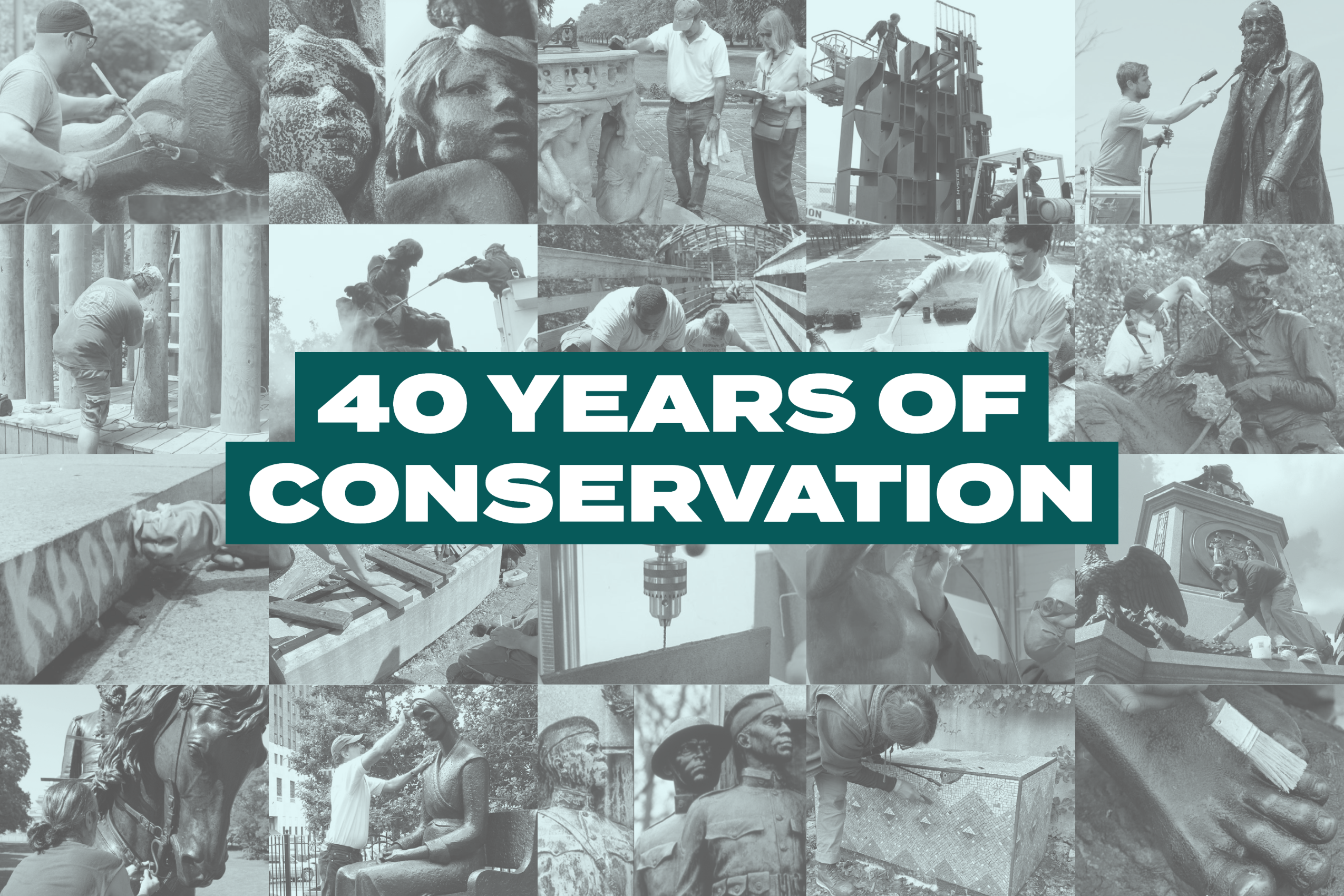Now in its 40th year, our conservation program is one of the longest continuously operating programs of its kind in the country.
The Association for Public Art (aPA) is wrapping up two big months of public art conservation projects in Philadelphia, performing much-needed restorations, repairs, and annual maintenance. Each spring, we provide conservation treatment for approximately 30 artworks in the city made of all kinds of materials (bronze, marble, wood, steel, etc.) and take on special projects as needed, like disassembling a massive I-beam sculpture for repainting! (More on that below.)
Now in its 40th year, our conservation program is one of the longest continuously operating programs of its kind in the country. Here’s a look at some of the work we did this season:
Disassembly: Major Restoration for Iroquois by Mark di Suvero
It was a smooth deinstall for the iconic red-orange Iroquois sculpture by Mark di Suvero, which was in need of repainting after 15 years of being exposed to the elements on the Benjamin Franklin Parkway. The surface was faded, chipped, and had other marks of wear and tear. It was a two-day job that required a team of professionals, including conservators, welders, and riggers. The I-beams were carefully disassembled and sent off in a flatbed truck to be stripped and repainted at an industrial paint facility in Delaware. The sculpture will return to the Parkway in September as part of the Association’s 150th anniversary celebration.
Q: Why did the sculpture need to be disassembled? Couldn’t it be repainted as is, on site?
A: Yes – but this is the longest lasting of any of the treatment options, and we wanted to invest in that. This approach is ideal because:
• The sculpture should remain in better condition for a longer time
• The coating can be applied under hardware and joined edges, providing more protection
• Surfaces can get a much more even coating in an indoor, controlled environment
• The conservators get a chance to thoroughly inspect and replace any hardware if necessary
The Association for Public Art acquired and installed Iroquois in 2007 thanks to the generous support of the late David Pincus. This conservation project is being undertaken and managed by Materials Conservation, assisted by Mammoet riggers, Color Works industrial paint contractors, Atlantic Coating Consultants (Independent Representatives of Tnemec Paint), as well as the artist’s studio, Spacetime CC. Funding has been provided in part by the generous support of the Pincus Family Foundation.
Bronze Cleaning and Wax Protection
For an outdoor bronze sculpture to be healthy, it needs a protective wax layer to help shield it from harmful environmental pollutants. The biggest threat to these sculptures is acid rain, which corrodes and weakens the bronze and gives it that bright green, sometimes streaky look.
The biggest threat to these sculptures is acid rain, which corrodes and weakens the bronze and gives it that bright green, sometimes streaky look.
Before the wax can be applied, our professional conservation team at Tatti Art Conservation washes bronzes with water and a mild detergent along with using a solvent to remove all sorts of accumulated surface grime, including car exhaust and pollen. Then the bronze is heated with a propane torch to drive out all the trapped moisture and prepare the sculpture to receive the wax coating, which is applied with a brush. Once the wax cools, the surface is buffed with soft cotton rags.
How often the wax needs to be reapplied depends on the environment and resources available. For large outdoor collections like Philadelphia’s, annual treatment with hot wax is ideal.
Artworks featured: The Mounted Amazon Attacked by a Panther (cast 1929) by August Kiss and Maja (1942) by Gerhard Marcks
The Smallest Details: Mosaic Repair
Getting the Manayunk Stoops: Heart and Home by Diane Pieri restored after damage caused by Hurricane Ida in 2021 (the storm that turned I-676 into a canal) has been a long road. The stoops were completely submerged underwater, and our conservation team from Materials Conservation removed mud, foreign objects, and mildew with a mild detergent.
The tile and mortar sustained some damage – chipped and missing tiles – but we needed to wait for warmer weather to make these repairs. This spring, new glass tesserae (mosaic tiles) were carefully chosen, cut, and fixed into place, and repair mortar was filled in and shaped where there were gaps.
Finding Litter Solutions
It’s no secret that littering is an issue in our city. We discovered that people have been throwing trash into the Wellhead (Stone Basin) in the Azalea Garden behind the Philadelphia Museum of Art, which is a marble artwork that we take care of. (It’s often confused with the Alexander Stirling Calder Sundial in Fairmount Park.) Pulling the trash out is no picnic.
Our initial solution was to custom fabricate and install a metal screen inside the basin. However, soon after installation the metal was bent (likely from something heavy), and we had to remove it from the site. We’re currently exploring other ways to tackle this ongoing situation.
The Wellhead, by an unknown artist, is adorned with playful, music-making urchins, and dates back to 16th-century France. Here’s a similar wellhead on view at The Met.
40 Years of Preserving Philadelphia’s Outdoor Treasures!
In 1982, the Association for Public Art (then the Fairmount Park Art Association) initiated a landmark sculpture conservation program for Philadelphia, which is now one of the longest continuously operating programs of its kind in the country.
The Association recognized the need to preserve Philadelphia’s existing sculpture history, even as we explored new directions and approaches to public art. As we looked toward the future, we were equally concerned with the treasures of the past.
It began as a two-year pilot program with generous support from the Mabel Pew Myrin Trust, with 16 works of historic and artistic importance selected to receive initial treatment, including Cowboy (1908) by Frederic Remington and Three Way Piece Number 1: Points (1964) by Henry Moore. These initial efforts evolved into a robust annual maintenance program that provides treatment for more than thirty public artworks in Philadelphia each spring.
“The Association recognized the need to preserve Philadelphia’s existing sculpture history, even as we explored new directions and approaches to public art,” said our Executive Director Penny Balkin Bach when the program first began. “As we looked toward the future, we were equally concerned with the treasures of the past . . . . From my point of view, the issues of care, maintenance, artistic intent, and environmental concerns are the business of all public art, no matter when the work is created.”
Your support helps us commission and preserve significant works of outdoor sculpture in Philadelphia, as we promote the important role of art and artists in the creation and enhancement of our public spaces.
Works That Received Treatment this Season:
• On Kelly Drive: Augustus Saint-Gauden’s James A. Garfield Monument, John J. Boyle’s Stone Age in America, Randolph Rogers’ Abraham Lincoln, Robert Morris’s The Wedges, Daniel Chester French’s General Ulysses S. Grant, Frederic Remington’s Cowboy, and sculptures in the Ellen Phillips Samuel Memorial, including The Spirit of Enterprise
• On the Benjamin Franklin Parkway: Gerhard Marcks’ Maja, Mark di Suvero’s Iroquois, Sylvia Shaw Judson’s Mary Dyer, Henry Moore’s Three Way Piece Number One: Points, Barbara Hepworth’s Rock Form (Porthcurno), and Alexander Stirling Calder’s Shakespeare Memorial
• Around the Philadelphia Museum of Art: August Kiss’s Mounted Amazon Attacked by a Panther, Albert Wolff’s The Lion Fighter, and the Wellhead (Stone Basin) by unknown artist
• In Rittenhouse Square: Antoine-Louis Barye’s Lion Crushing a Serpent and Paul Manship’s Duck Girl
• Around the Fairmount Park Horticulture Center: Martin Puryear’s Pavilion in the Trees, Edward Stauch’s Night, Alexander Milne Calder’s Major General George Gordon Meade, and Alexander Stirling Calder’s Sundial
• In West Philadelphia, including Frank Edwin Elwell’s Dickens and Little Nell and Jacob Epstein’s Social Consciousness
• Other locations: Jody Pinto’s Fingerspan in the Wissahickon, Daniel Chester French’s Law, Prosperity and Power at the Mann Center, John Kindness’s The Labor Monument in Elmwood Park, and Ed Levine’s Embodying Thoreau: dwelling, sitting, watching in Pennypack Park



